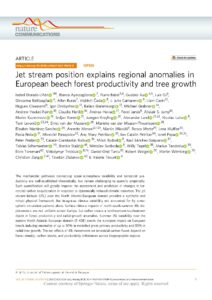
Résumé : The mechanistic pathways connecting ocean-atmosphere variability and terrestrial productivity are well-established theoretically, but remain challenging to quantify empirically. Such quantification will greatly improve the assessment and prediction of changes in terrestrial carbon sequestration in response to dynamically induced climatic extremes. The jet stream latitude (JSL) over the North Atlantic-European domain provides a synthetic and robust physical framework that integrates climate variability not accounted for by atmospheric circulation patterns alone. Surface climate impacts of north-south summer JSL displacements are not uniform across Europe, but rather create a northwestern-southeastern dipole in forest productivity and radial-growth anomalies. Summer JSL variability over the eastern North Atlantic-European domain (5-40E) exerts the strongest impact on European beech, inducing anomalies of up to 30% in modelled gross primary productivity and 50% in radial tree growth. The net effects of JSL movements on terrestrial carbon fluxes depend on forest density, carbon stocks, and productivity imbalances across biogeographic regions.
Consultez la notice complète de l’article sur ORBi
